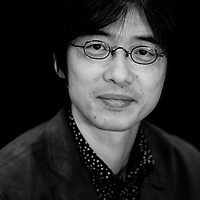Glimpses of unfamiliar France
by Mika Provata-CarloneGlimpses of Unfamiliar Japan is the title of an idiosyncratic account of Japan as a country, as a philosophy, as a world and way of life, as the seductive Other seen through Western eyes. It was written by a rather remarkable man, Lefkadio Hearn (who became Koizumi Yakumo), now mostly forgotten. It is an intimate log of audacious steps of rapprochement and of impossible distances, of encounters that for all their brevity, vicariousness or eccentricity, hold in them lifetimes of meaning. It is also a private diary of transformation, of the interplay between selfhood and assumed identity, an unfinished apologia of why the place furthest away, real and metaphorical, could perhaps be home.
The Bear and the Paving Stone is full of echoes of a similar process in reverse. What is exoticised and orientalised here is France, what is questioned is how much a total immersion in another culture makes us other than who we are, or, in fact, even more strongly ourselves. Three short stories embroider a tapestry of philosophical peregrinations, an imagistic tableau of states of being. Each is infinitely simple and yet highly symbolic; each has inimitable uniqueness and the versatility of universal currency; each is surfeit with references, allusions, textures and layers, an almost infinite number of voices. Most of the voices are French, from La Fontaine and his fables, which give this episodic novel its title and apparent raison d’être, to the story of Littré from religious persecution to dictionary glory; some are unabashedly European or Anglo-Saxon, from L.M. Montgomery’s Anne of Green Gables to the haziest hues from Nabokov’s Lolita or Thomas Mann’s Death in Venice, to the stories of Saki. But the backbone of this shimmering short novel is Japan – its literature, its insularity, the abstraction that is also the most concentrated distillation of its humanity.
One could say that Flaubert’s flâneur meets in his pages the philosopher-traveller-poet-citizen of Bashō, and that this is a vision of the world as perceived through Edo eyes.”
The Bear and the Paving Stone is monogatari in the most traditional sense, told anew and daringly by Toshiyuki Horie to encompass the transcendence that both time and cultural experience have grafted upon Japan’s vital fibres. One could say that Flaubert’s flâneur meets in his pages the philosopher-traveller-poet-citizen of Bashō, and that this is a vision of the world as perceived through Edo eyes – when haiku poetry flourished, when humour and spiritual depth walked side by side, when the travel diary (or the humorous travelogue) becomes a major literary form (Jules Verne will try his hand at it with gusto in 1879, with his Tribulations of a Chinese Man in China). Especially when the artist existed in an oblate state of being, outside yet organically part of every gesture and movement, every thought and dream. The Bear and the Paving Stone has characters that are indissolubly connected loners and belongs both to a postmodern kind of realism that constantly references 19th-century French writing, and to the ‘floating world’ genre of Horie’s homeland.
Horie likes to thwart readerly expectations and to challenge the instinctive responses of our humanity. He creates sharp, stark and palpable contrasts between past rhythms and paces of life, of an older, pre-21st-century perspective, and a contemporaneity that seems to have eradicated the traces of memory – and perhaps does not make allowances for a new writing of remembrance, of being-in-time. His characters (the unnamed first person narrator and the friends, old and new, he meets again or makes on his way) are capable of the strongest grip on the reader’s emotions, while being at the same time drawn in the sketchiest, most fleeting manner, in faded colours, erased lines, blurred reverberations of words. Each represents a meeting, a convergence of lives, and often not a single but many tragedies; each holds a promise of happiness unfulfilled (or perhaps impossible). They are in their totality the poetic (and very real) expression of the enchanted loneliness of exceptional lives.
Horie gives us a fly-on-the-wall perspective of these almost unbearably delicate encounters, of moments when lives and consciousness touch, fuse, while still distinct, come into true communion – or disintegrate in lost possibilities, as though the art of attachment, of communicating meaning, were the most endangered species in a precarious world. Old words must be used for new meanings, or even, and especially, for meaninglessness. There is a distinct pleasure in the physicality of words, thoughts and emotions, in the ethereality of material objects that anchor our existence in this world. In the third story, a very emotive, relentless questioning of the genuineness of human emotion, Horie asks us to consider the sandcastle paradigm: what is the value of permanence or impermanence? Are sandcastles and the pleasure of watching the tide engulf what one has built with great effort, more enduring than reinforced concrete megatheria? French châteaux built of sand on a Japanese beach become metaphors of our dreams, of the gentle humour in the regular absurdity of human logic, as well as an elegy to another culture, history, way of writing and being that for Horie is second nature, and a primary element in his own life. The French maxim that le temps passe, les amis restent becomes, perhaps, friends pass, time stays.
There is a Chekhovian approach to wisdom and foolishness, angels and monsters, and especially to life-lies and necessary illusions.”
Displacement and wandering, life’s centrifugal and centripetal drives, are prisms through which Horie proceeds to tackle both man’s aspirations and visions and his irrationality, the perverse power his reason can exert over his soul and sensibility. Behind the levity of the feigned surprise at the peculiarities of the French (currant-picking contests, over-gregarious, precocious children, and camembert-throwing championships) lie stories where cruelty or the tragedy of loss and trauma are inextricably mixed with the aching longing to simply be or to be acknowledged in a gaze. Derelict farms, mute animals, desolate yet inhabited landscapes, industrial relics, but also scenes of contemporary abandonment and decline, such as immigrants, beggars, people engulfed in a solitude that is or is not of their own making, are the subjects of the photographs that Yann, the narrator’s friend, takes as a way of confirming a purpose beyond devastation. The subtext is the Holocaust, not a narrative Holocaust or the Holocaust of scholarly history, but the Holocaust of a very personal memory, an absolute gauge of good and evil, of possible or impossible survival. The chimneys of a pork-smoking factory become the chimneys of the crematorium where Yann’s family was murdered. There is one pot for each terminated life. Littré’s conversion to Catholicism also becomes invested with the weight of a will to nothingness that has branded human history, while Jorge Semprún’s Buchenwald story, Primo Levi’s death and Bettelheim’s suicide stand, in Horie’s pages, as silent witnesses to our own life choices, our guilt or innocence with regard to our world’s meaning and human quotient.
There is a Chekhovian approach to wisdom and foolishness, angels and monsters, and especially to life-lies and necessary illusions. There is apparent childishness and the engagement with words as the vehicle of a meaning that belongs to others (the narrator is a translator), but there is, above all, truly original writing that offers a shrewd reflection on our tribalising globalism and the claims that identity, conscience and a sense of belonging are artificial constructs. The richness of cultural identity and nationhood emerges strong and delicate at the same time, as does the infinite exercise of examination, awareness, evaluation, ethical doubt that it requires. Horie asks questions about erasure and presence, the possibility or impossibility of empathy, of the sharing of pain, about home and rootlessness and the vital force of a tradition, the experience of absence, the traces of memory, the feeling of exclusion or bereavement.
This is an eccentric read, in the sense that it thrives on tangentials, and is unafraid to leave loose threads unattached. It is a rather beautiful, very funny, often bitter or sadly gentle book that will entice and satisfy while leaving one thirsting for more. Geraint Howells’ translation feels as though it occasionally lacks the subtleties of Horie’s original, staying on a literal level of inscrutability and perhaps missing some of the allusions or literary reflections and inflections, yet the strength and distinctiveness of Horie’s voice is unmistakable, and more of his work in English would offer perfect confirmation of his resonance.
 Toshiyuki Horie (born 1964) is a scholar of French literature and a professor at Waseda University. He has won many literary prizes, including the Mishima Yukio Prize, Akutagawa Prize (for The Bear and the Paving Stone), the Kawabata Yasunari Prize, the Tanizaki Jun’ichiro Prize and the Yomiuri Prize for Literature (twice). The Bear and the Paving Stone, translated by Geraint Howells, is published by Pushkin Press.
Toshiyuki Horie (born 1964) is a scholar of French literature and a professor at Waseda University. He has won many literary prizes, including the Mishima Yukio Prize, Akutagawa Prize (for The Bear and the Paving Stone), the Kawabata Yasunari Prize, the Tanizaki Jun’ichiro Prize and the Yomiuri Prize for Literature (twice). The Bear and the Paving Stone, translated by Geraint Howells, is published by Pushkin Press.
Read more
Mika Provata-Carlone is an independent scholar, translator, editor and illustrator, and a contributing editor to Bookanista. She has a doctorate from Princeton University and lives and works in London.


